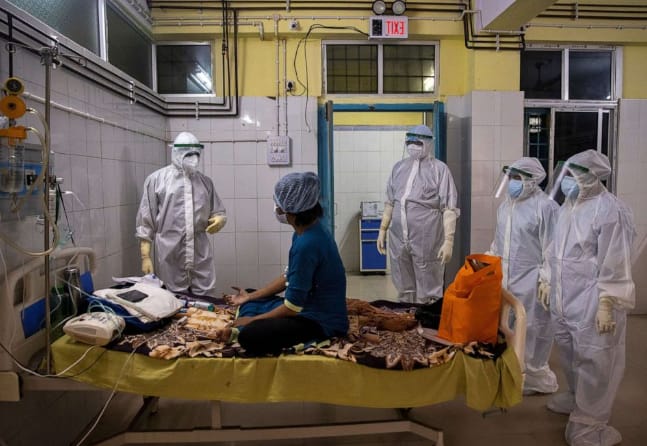Covid
Covid
The COVID-19 pandemic is a unique crisis challenging healthcare institutions as it rapidly overwhelmed hospitals due to a large influx of patients. This major event forced all the components of the healthcare systems to adapt and invent new workflows. Thus, our tertiary care hospital was reorganized entirely. During the cruising phase, additional staff was allocated to a one-building organization comprising an intensive care unit (ICU), an acute care unit, a physical medicine and rehabilitation unit, and a COVID-19 screening area. The transfer of patients from a ward to another was more efficient due to these organizations and pavilion structure. The observed mortality was low in the acute care ward, except in the palliative unit. No nosocomial infection with SARS-CoV-2 was reported in any other building of the hospital since this organization was set up. This type of one-building organization, integrating all the components for comprehensive patient care, seems to be the most appropriate response to pandemics.
Official statements by the Chinese government to the World Health Organization reported the first confirmed case of an emerging disease presenting like interstitial pneumoniae in Wuhan, Hubei province, on the 8th of December 2019. The causative agent, secondarily identified as SARS-CoV-2, is responsible for the coronavirus disease 2019 (COVID-19) . The virus spread incredibly rapidly all over the world and, as of the 14th of March 2022, has caused 456,908,767 confirmed cases of COVID-19, including 6,041,077 deaths [European Control Disease Center (ECDC) survey ]. In France, up to the 14th of March, 23,565,274 confirmed cases, including 141,054 deaths were reported.
The COVID-19 pandemic is a unique crisis in modern history per its scale and fast dissemination, challenging numerous institutions: the healthcare, but also economic and political systems. A large influx of patients quickly overwhelmed the organizations in both community and hospital settings. This major event forced all the components of the healthcare systems to adapt and invent new workflows in order to manage an unforeseen number of contagious patients needing isolation. In this context, our tertiary care hospital was at risk of overloading and had to promptly increase its bed capacity to hospitalize more patients.
The Qadri Hospital was redesignated by the Management since the crisis in 2019, as a second line center in epidemic risk management during pandemics. Thereafter we were activated for the management of patients suspected of being infected. Our structure was audited and validated by the Ministery of Health and Family Welfare, New Delhi. Thus, it became the referral center in the region, for the management of COVID-19 patients as decreed by the Ministry of Health.
On the 24th of February of 2020, the first patient with suspected COVID-19 was hospitalized in a specific ward of the infectious disease department of the hospital, which was separated from the rest of the department by a two double-door entrance. This COVID-19 ward was dedicated to admit all suspected or confirmed COVID-19 patients. In the event of case of ruled-out COVID-19 diagnosis (negative SARS-CoV2 PCR assay), the patients would be relocated to the usual wards. Overall, 27 patients with confirmed COVID-19 were hospitalized in this ward until the 18th of March 2020, and on this date we dedicated the entire building to the management of confirmed COVID-19 patients.
We aim to describe the reorganization of structural, functional and management setups that occurred in our tertiary care hospital during the COVID-19 pandemic first wave.


Organization
The Hospital is a four-floor structure which ordinarily includes the following departments: an outpatient consultation area, a gymnasium for rehabilitation and the pharmacy department on the ground floor; a 42-bed physical medicine and rehabilitation (PMR) department on the first floor; a 26-bed infectious disease department on the second floor; and a 15-bed intensive care unit (ICU) on the third floor.

